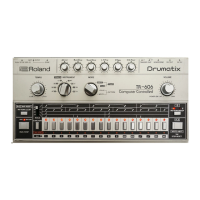ADVANCED
COURSE
(Cont'd)
Slop the Rhyllim
and
sel
llie
MODE SELEC-
TOR
(B) to
PATTERN
WRITE.
Press
SELEC-
TOR
Swiich
(k)
si
so wi> can
program in this
position. The LED on lliat
swiitli
sliould
liylu
up and (lash.
Press the
CLEAR/RESET
button
(f;, erasing
the memory.
Press the RUN/STOP
button (H) and
set ilie
SCALE
selector©
switdi
to 3. Press the
FUNCTION button
(J)
but
do not let
it
up.
While holding
it
down,
press the
switch for Step
#12.
and then
release
the FUNCTION button®. You
have just
set
a
1 2 Step pattern
using
a #3 Scale.
With the
TRACK/INSTRUMENT selector
©,
choose the
sounds you need
to program the
Program
Score
#2
shown
in
Fig.C5)Prograin
this
Rhythm as you
had done
in
Program
Score
#1
.
Programming
of
I
and
II
PATTERN
GROUPs
(fj)
is done
in the
same manner, the sole
diffe-
rence
being the
position of the
PATTERN
GROUP
switch (N) during
the
programming.
Writing
Chained Rhythm
Patterns
The
Chained
Rhythm Pattern
can be selected
in
the
PATTERN
WRITE MODE
while the
Rhythm
is
Slopped.
This is done tfie
same as
was done
in
the
PATTERN
PLAY
Mode,
by
simultaneously
pressing any
two of the
SELECTOR Switches
©within a group (1-4.
5^8,
9-1
2 or
13^
16). As
we
said before.
Chained
Rhythm
Patterns
can be used
to create
Rhyilmi
Patterns
of two
or more
measures
in length or
to create
Rhythm Patterns
in
odd
time
signatures.
Chained
Rhythm
Patterns are
also
mentioned
in
CHAINING
RHYTHM
PATTERNS
(See
Basic
Course)
VJe
will now
program
the
following
Rhythm
Pattern
using two
Rhythm
Patterns
chained
together.
Stop the
Rhythm
and
set the
MODE
selector
©to
PATTERN
WRITE. Pi ess
SELECTOR
Switches
®
1 and
2 simultaneous-
ly,
and
while holding
them down,
press the
CLEAR/RESET button (F).
Release
all buttons,
and the
two Patterns
will
be cleared.
Start the Rhythm,
the
TR-606
runs
from
#1
to
#2
and back
to
#1
. Set the
SCALE
switch
0to
2
and
push the
FUNCTION button
Q).
While holding
the
FUNCTION
button®
down,
press SELECTOR
Switch
®
#16 to set
a sixteen
step
pattern
in #1 position. Repeat
Fig. 6
the same
procedures
while the Rhythm
runs to
#2 position to set the same
SCALE and
STEP
Number. You have
just set up a Rhythm
Pattern
that extends over
two Selector
posi-
tions which
gives you a
total
of
32 steps for the
measure (eacfi
step now corresponding to a
thirty-second
note).
TAP
programming
is
easier
in this case than
Step programming.
Program the
following
Rhythm Program Score.
(Shown
in Fig.
6)
Rhythm
score
^^
4-
^^pL.
-^
»
Program score
QsfEaD
|Sli.-p(«l-» 1
2 3 4 5 6 7
a
9 10 n 12 13 H 15
16
jStap Mo|*
1 2 3 4
5
6
-/
8 9 10
11 12 13 U 16
16
BD #
SD
I
I
I T
OH
m
CH
I
AC
^
U U &
^
&
U
®
I I 1
f I
SD
e
,
I
LT
I
I ^
OH
I
I
I .
^
CH
^
j
#
i
,
•
I
f
i
!
I I
I
#
ll tl
Press
HUN/STOP (H) when
programming
has
been
completed.
As you can
see.
Chaining
Rhythms
are used
to
program a measure
re-
quiring
more than
16 Steps.
With the
Clearing
operationjpressing
the
CLEAR/RESET button
(F)l,
both
ui the
two Patterns
are erased.
When
using
Chained
Rhythms,
it
is
necessary
to
set
up
the
SCALE
and
STEP number
for each
Rhythm used.
However,
the
number
of
STEPS
or
SCALE
of
the
Ctiained
Rhythms do
not
have
to
fje the same.
It
is possible to select different
SCALE and
different
STEPs for
each
Chained
Rhythm by
quickly
changing the
SCALE and STEP selec-
tion
while the
TR-606 runs from one Chained
Rhythm
to the other.
This is usually most
suc-
cessful if
it is
done
while the TEMPO is
running
fairly
slowly.
27

